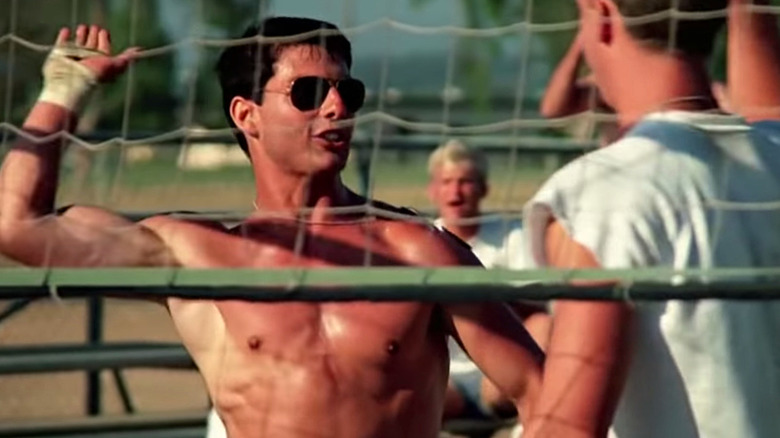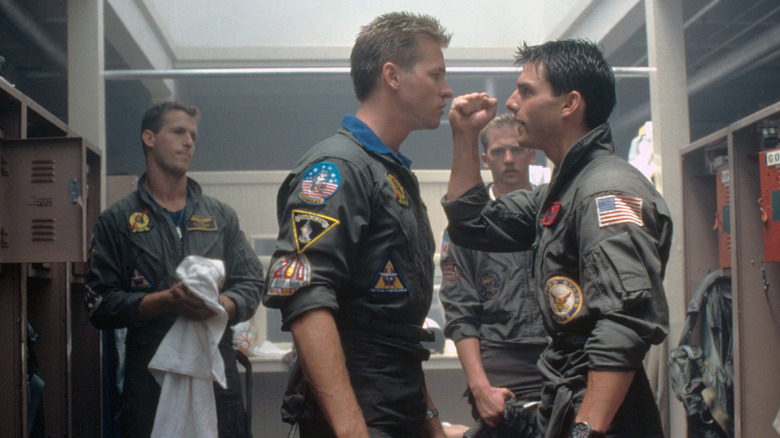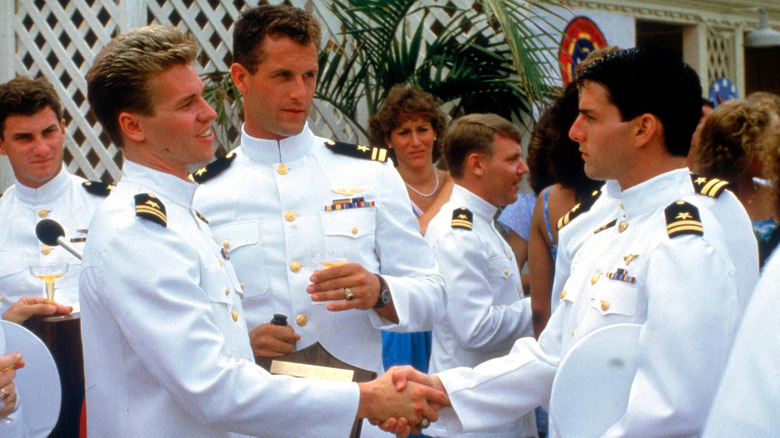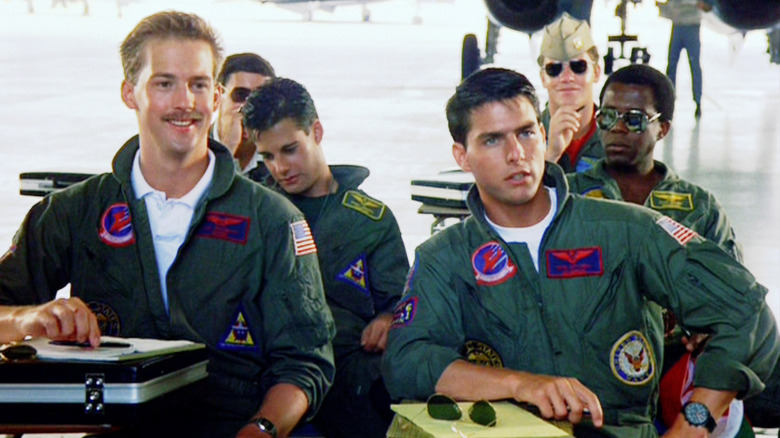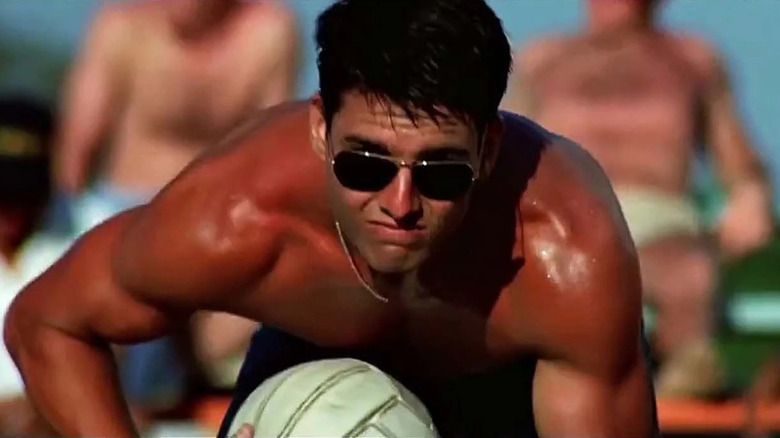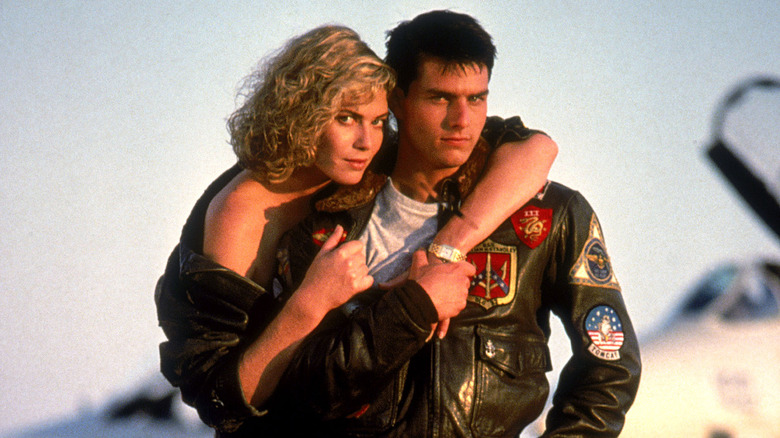How Top Gun Became A Gay Classic
Over 36 years since the release of "Top Gun", its long awaited sequel is finally premiering in theaters. "Top Gun: Maverick" sees the return of Tom Cruise as Pete "Maverick" Mitchell, the hot-shot Navy pilot with a need for speed and a penchant for ignoring the rules. Directed by Joseph Kosinski, taking over from the late great Tony Scott, the movie has received near-universal praise from critics, thanks to its astounding stunt work and evolution of its central character. Deadline even declared that it "tops the original in every way imaginable" while our own Ben Pearson said "this could end up being one of the most crowd-pleasing and satisfying movie experiences of the year."
The original "Top Gun" is a fascinating movie, an unabashedly propulsive blockbuster that is proudly a product of its time. It's pure '80s cheese, complete with Kenny Loggins songs, high-concept stunts, and good-old American patriotism dialed up to 100. It's also, to put it bluntly, one of the most homoerotic movies ever made.
Top Gun's homoeroticism
It's truly fascinating how unbridled the homoeroticism of "Top Gun" is. For a movie made by mainstream Hollywood in the midst of the AIDS crisis, it's a remarkably warm depiction of male friendships that cannot help but take on the steamy and giddy air of queerness. Google "Top Gun Gay" and you'll get a hefty 1,390,000,000 results. This reading isn't something that audiences later projected onto the film through fan theories and nostalgic reconsiderations.
Everyone called it out in 1986, from critics to audiences. In her review, critic Pauline Kael said that "the movie is a shiny homoerotic commercial [...] It's as if masculinity had been redefined as how a young man looks with his clothes half off." Quentin Tarantino would famously give voice to the theory that the film is actually a gay love story via a typically Tarantino-esque monologue in the movie "Sleep with Me." Neither he nor Kael are wrong.
There are so many scenes of sweaty muscled men strutting around one another like prowling peacocks, clad in nothing but towels that seem ready to fall to the floor at a moment's notice. The guys play volleyball in the scorching sun in a scene set to the Loggins song "Playing With the Boys." It's hard not to be taken in by lines like "you can be my wingman anytime" and "I want somebody's butt, I want it now!"
The true romance
And then there's the chemistry between Cruise and Val Kilmer as his main competition, Iceman. Practically every scene between the two men reeks of the energy of two petty exes who aren't really over one another. In one oft-memed scene, Iceman cheekily bites at Maverick in a moment that would be the peak swoon-worthy moment of any romantic comedy. Sure, Maverick eventually ends up with the lovely Kelly McGillis but the real heat is with Iceman, and the true emotional climax his ability to move on from the loss of Goose, his best friend with whom he has far more emotional chemistry than any woman.
The imagery of "Top Gun" speaks for itself. We revel in shirtless volleyball set to the least subtle scene ever, and moments where men say to one another things like "I'd like to bust your butt, but I can't!" But watching the film in 2022 as this relic of unexpected gayness is still a curious experience. The subtext is undeniable but the movie also spends a lot of time emphasizing Maverick's straightness. Cruise and McGillis do a lot of sloppy open-mouthed kissing that screams "I'm straight, guys!" (But you can totally still read it as him trying too hard to prove something.) The straight romance is still the moment that ends the film, the conclusion to Maverick's narrative and the ideal Hollywood ending. There are moments of the movie that are so startlingly gay that they go right back round to being hetero.
The filmmakers react
The queerness of "Top Gun" has now been widely accepted by the mainstream, even if it wasn't wholly intentional on the part of the filmmakers. In the commentary on the physical releases of the film, Tony Scott said he found inspiration for the aesthetic of "Top Gun" in a book of black and white photographs by gay photographer Bruce Weber. "Everyone was scared because it was infamous in terms of the gay community, this book," said Scott. He also acknowledged that the film had become popular with gay audiences.
Producer Jerry Bruckheimer was interviewed by Vulture last year for the movie's 35th anniversary and was asked about the subtext, specifically as it's discussed by Tarantino in "Sleep with Me." He said:
"When you make a movie, people can interpret it in any way they want and see something in it that the filmmakers had no idea they were tapping. So we're surprised every time we hear something talked about, or written about, the films that we make that have no real context for the filmmakers or what the filmmakers wanted to do. And yet there's a relevance to them, because people believe it [...] Coming from Quentin, it's always a compliment."
An unexpected queer classic
It's pretty cool and kind of a relief that the filmmakers did not shirk at the notion of their uber-macho, peacock strutting movie of military men being seen as anything less than stridently heterosexual. It would have been wearily unsurprising had such responses elicited gay panic, especially given the startling homophobia of the era. Remember, this was a time when the LGBTQ+ community was dying en masse thanks to a plague that the sitting president refused to acknowledge or do anything to stop.
There's also a cathartic thrill to be had with seeing a film that is pure military propaganda be this gay, given that it was illegal to be out and serving in the '80s (the Department of Defense declared in 1981 that "the presence in the military environment of persons who engage in homosexual conduct or who, by their statements, demonstrate a propensity to engage in homosexual conduct, seriously impairs the accomplishment of the military mission." They must have not liked volleyball.) Queer representation of any kind was extremely rare, particularly in films of this scale, and gay jokes were common. So, "Top Gun" embracing its reputation warms the heart in its own bare-chested way.
Top Gun in 2022
But what makes "Top Gun" so interesting to watch is what they reveal about our staid ideas of masculinity. These moments that we think seem gay are positioned here as guys being dudes, just friends and colleagues hanging out and enjoying themselves free of scorn or judgment. This kind of intimacy between men, even when it isn't romantic or sexual, comes with its own undeniable passion. It's refreshing to see, even if you take out the queer reading. How many films have you seen where guys refuse to hug one another or be open about their feelings because it would be seen as too gay to do so? The refusal to categorize certain types of behavior as "gay" or "straight" is a powerful move that disrupts homophobic mindsets. Would that more pop culture stories be so candid about masculinity.
However you read "Top Gun," it's a film that remains a unique time capsule of its time. It seems unlikely that "Top Gun: Maverick" will top its predecessor in this way (all jokes intended) but as we finally see slivers of LGBTQ+ representation in these mega-blockbusters intended for worldwide audiences, perhaps we owe a salute to Maverick and Iceman for their inadvertent contributions to the cause.
